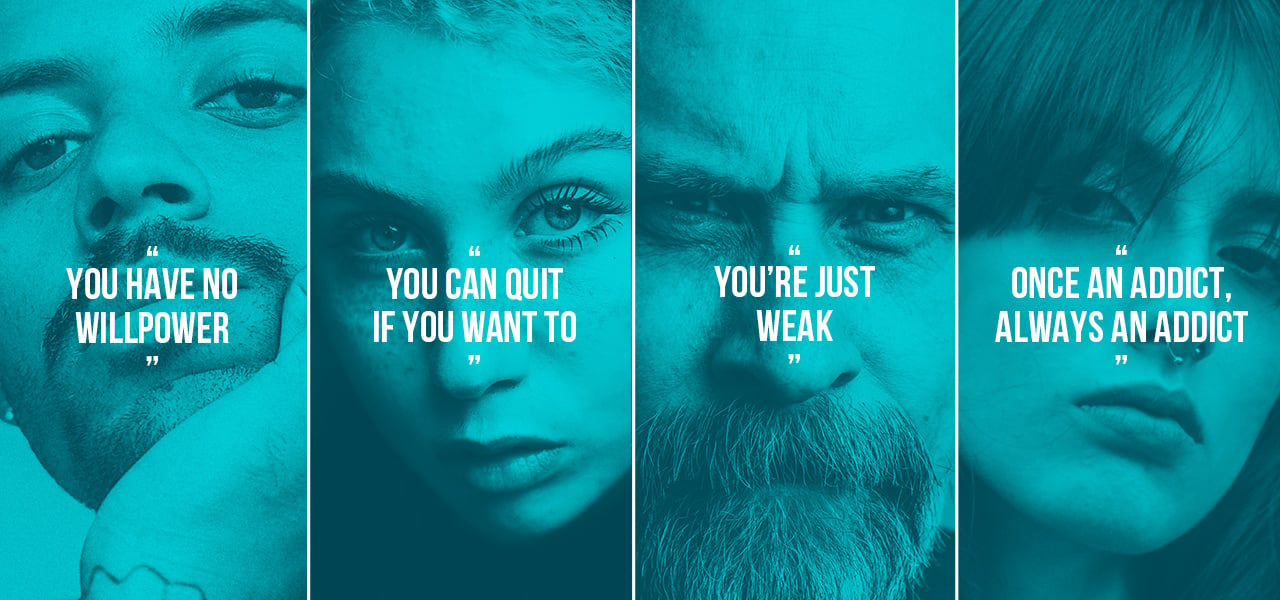Convincing yourself, a friend or a loved one to go to treatment could be one of, if not the, hardest things you’ll ever have to do in your life. And the myths surrounding addiction don’t make it any easier. Not only do these false facts hurt families and friends, they stand in the way of helping people get the help they need to get better. They also stigmatize those struggling and negatively impact views about treatment and recovery. Truly understanding addiction is the first step towards healing, so it’s time to separate fact from fiction.
Myth #1: Addiction is a choice.
Reality: While it’s true that it is a choice to use a substance the first time, no one actually chooses to be addicted to it, in the same way they wouldn’t choose to get cancer or diabetes. In fact, addiction is a consequence of a number of contributing factors including genetics, which account for up to 50% of a person’s likelihood that they’ll develop one. It’s an important distinction, not only for the person suffering and how they perceive their own condition, it’s also important for loved ones to understand so there’s no blaming and shaming.
Myth #2: Willpower is enough to break an addiction.
Reality: Perhaps one of the most common myths out there, addiction has forever been referred to as a moral failing and those who suffer simply aren’t strong enough to overcome it. Many believe that addicts are broken or have something wrong with them. In reality, strength of character has literally nothing to do with it.
For those who are vulnerable, substance abuse leads to profound changes in the brain. When addiction takes hold, self-control and the ability to make good decisions goes out the window and gets replaced with an intense impulse to do more. Interestingly, these brain waves operate on the same circuit as survival, meaning those strong urges are no different than the need for food and water. That might help explain the compulsive and often puzzling behaviour around addiction (for example, how people keep using even though the world is falling apart around them).
Myth #3: Only certain types of people have substance abuse issues.
Reality: Science has confirmed that addiction is, indeed, a chronic brain disease that can happen to literally anyone, it does not discriminate. However, many assume that if someone has a stable job, they come from a good home or are considered successful in their professional lives, they couldn’t possibly be suffering from addiction. In reality, addiction can and does affect all kinds of people: mothers, fathers, uncles, aunts, sisters, brothers, sons and daughters.
Myth #4: Treatment is a miserable and isolating experience.
Reality: It’s quite the opposite, actually. Though the person struggling may be away from their loved ones, addiction therapy is a community full of like-minded people sharing similar experiences, as well as counselors and medical staff. While the emotional work can be challenging, these group settings can help people set and achieve goals towards recovery, while getting cheered on by others along the way. This is also a time to relax and reflect away from the usual triggers, while enjoying a number of leisurely and creative activities.
Myth #5: People have to hit rock bottom before they can get better.
Reality: Not only is this myth untrue, it’s extremely dangerous. The longer a person waits, the sicker they become and the harder they will be to treat. More importantly, the possibility of deadly consequences goes up significantly. Recovery can begin at any point in the addiction process–and the sooner, the better. People that get help before their illness is so severe have far more resources to draw upon, including family and friends, to help them recover successfully.
Myth #6: If someone relapses, they’ve failed.
Reality: Relapse is not defeat. Though it may seem like failure, it’s actually a part of the recovery process. It does not mean that the individual, or sobriety, is a lost cause. Getting better is a long journey that involves changing deeply embedded behaviours, which sometimes results in setbacks. It doesn’t mean previous treatments have failed, as there is still progress that has been made in the process.
It also may be a sign that the treatment plan needs to be changed. Relapse prevention strategies may need to be put in place to help identify the early signs of relapse and provide coping skills to help with the cravings and stressors.
Myth #7: Going to treatment will fix the problem.
Reality: As already mentioned, addiction is a chronic disease, meaning it’s a long-lasting condition, and while it can be controlled, it cannot be cured. While it’s true that most people live long and happy lives after rehab, recovery takes commitment, support and ongoing vigilance. Treatment is a huge first step toward health and wellness, but it’s only the beginning. People still need to work on themselves. That’s why extended care, aftercare, and community programs exist, so the individual can continue to have a support system to help manage the disease long after rehab is over.
Myth #8: People can detox on their own.
Reality: Not only is this a huge myth all around, for the person suffering from addiction, it can also be another manifestation of denial. While the idea of self-detox sounds much easier than committing to an entire treatment program, the latter has a ton of the resources needed to not only tackle the disease head on, but help the individual avoid the severe discomfort of withdrawl. In treatment centres, there are doctors on hand who can prescribe medication and assist with the process in a safe, professional setting so it’s done as comfortably as possible.
Myth #9: It’s easy to spot someone struggling with addiction.
Reality: It’s not always as transparent as it seems.When most people think about addiction, they picture an old man in tattered clothes holding a brown paper bag and stumbling around. This is one of the biggest addiction stigmas in existence. In fact, many of those struggling go to great lengths to cover up their addiction from loved ones or employers to hide their shame. Unfortunately, this often keeps the person in the cycle of abuse longer allowing the disease to progress further and further.
Here are some signs to look out for if you suspect a loved one is suffering from addiction:
- Unpredictable mood swings
- Change in personality or behaviour (like anxiety, irritability, depression)
- Withdrawing from friends and loves ones
- Financial trouble
- Physical changes (like weight loss/gain, blood shot eyes, fatigue)
Myth #10: Addiction treatment is too expensive.
Reality: Substances themselves and the long-term effects of substance abuse are far more expensive. In fact, not seeking treatment can be more devastating to a family’s finances in the long run. While it’s true that some treatment programs can be pricey, there are always financing options available and payment plans that can be worked out. Many substance abuse treatment programs are also covered or partially covered by private medical insurance.
Myth #11: An intervention can do more harm than good.
Reality: Many are adverse to holding an intervention for fear that it will be an angry confrontation and they don’t want the person to feel like they’re being ganged up on. Not surprising, as many people who face interventions do feel as though they’re being ambushed by their loved ones and left with feelings of shame, embarrassment and guilt.
However, when done properly with the help of a professional mediator, interventions can be a very effective solution. Mediators not only help guide the process, but they also let friends and family members focus on the issue at hand in a calm and productive way. When an intervention is planned carefully and thoughtfully, the individual is much more likely to be open to getting the treatment they need.
If you’re concerned about yourself or someone you love, the best thing to do is reach out. Though it may seem scary at first, it has to start somewhere. That momentary discomfort doesn’t even close to compare to the dangers of ongoing addiction. Remember, there is no time limit in the process of recovery, everyone is different so it’s important to take it in strides. Rest assured, that no matter how much money you have, what the substance is, or how bad the situation, there is always an effective treatment option available.



